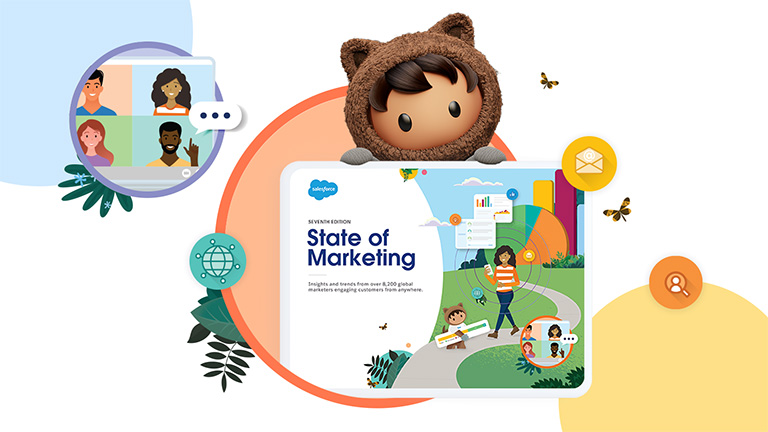Between 41-54% of Indian marketing leaders say that they have completely changed their marketing strategy in key areas, due to the pandemic. This includes areas like digital engagement, channel mix, data management, content, and organisation.
This is stunning, and shows that the new normal in 2022 will look very different from 2019.
The Seventh Edition of Salesforce’s State of Marketing report highlights that some of the top priorities and challenges for Indian marketers actually overlap. This presents a unique opportunity - solve these challenges and you can address your priorities at the same time.
Here’s how:
Real-time customer engagement needs real-time data visibility
Real-time customer engagement was found to be a top priority for the 300 marketing leaders surveyed from India. This is in line with the rising customer preference for relevant and hyper-personalised marketing communication across channels.
To achieve such 1:1 engagement, marketers will need instant visibility into customer data to know what their audience wants and when. This means understanding, quickly and at a granular level, customer preference, location, purchase history, prior brand interactions, and buying stage, among other things.
The solution can be found in customer data management platforms that unify all of the customer data for a single, unified view of each customer profile. Such a platform offers real-time cross-channel insights, allowing you to analyse and adapt engagement strategies in the moment.
Cohesive journeys call for cross-functional sync
When it comes to building cohesive customer journeys across channels and consumer devices, a lack of organisational synchronisation can be a big challenge. Inaccessibility to customer data lying with the different departments (sales, service, and marketing) prevents marketers from tracing customer touchpoints and interactions end-to-end. Result? Siloed efforts and fractured customer journeys.
To build cohesive customer journeys, ensure that teams and departments work together as a single, dynamic entity. If the company’s workflows or policies are not set up for this, a suitable amount of restructuring may be required to allow cross-team collaboration and role-based access to cross-functional data. The customer data resting on all other systems, devices, and applications in a company – whether in the cloud or on-premise – needs to be integrated and unified as well.
From a technology standpoint, organisations can adopt an integrated CRM solution that brings all the relevant customer data from across the organisation on a single platform. Look for a solution that also enables smooth API-based integrations with third-party data sources.
Improved marketing ROI lies in data analytics upskilling
41% of Indian marketers have completely revamped their organisational priorities this year. And as part of this narrative, they are particularly focused on improving marketing ROI. But to drive improved ROI, marketing teams must be adequately equipped to make informed decisions and strategies.
B2B and B2C companies have reserved 20% and 12% of their marketing budgets respectively, for upskilling of teams. Some part of these budgets can be used for much-needed training in state-of-the-art marketing tools and technologies such as data visualisation and AI-enabled analytics. Such an upskilling will help marketing teams use the right tools and interpret data to leverage the right opportunities and continuously improve performance as they, among other things,
- Avoid vanity metrics
- Use actionable metrics to inform decisions
- Try innovative marketing campaigns
- Perform A/B testing on campaigns
- Identify the most effective marketing channel(s)
- Analyse market and customer sentiment
Getting collaboration right to overcome marketing challenges
Working remotely has changed the way teams collaborate, and boosting efficiency in times of remote collaboration remains a top priority.
Marketing is a creative field that requires rigorous brainstorms and a continuous exchange of ideas, creating the need for regular, seamless collaboration. Since the pandemic’s early days, marketers have ramped up the use of collaboration platforms to digitalise workflows and build digital-first teams. But the employee response to virtual collaborations has been a mix of ‘completely satisfied’ and ‘not working out for me’.
As hybrid working becomes the norm, standalone collaboration platforms for instant messaging, emails, content management, project updates, etc. will no longer work. A single, robust collaboration platform that enables seamless and secure real-time communication and information search-share-retrieval is the need of the hour.
Fuelling innovation with accelerated use of marketing tools and technologies
Outdated marketing tactics will not only fail to attract new customers but also frustrate the existing ones, leading to high attrition rates.
For a customer to appreciate the ‘newness’ in marketing communication and feel compelled to try a brand, the entire marketing mix will require an upgrade. The 4 Ps – product, price, promotion, and place – will need a pumped-up strategy. This calls for quick and easy access to data, metrics, and insights that trace all selling initiatives - from pre-sales to post-sales. The end-to-end visibility will enable contextual, relevant interactions and one-to-one personalisation at scale, contributing to business growth.
Both B2B and B2C sectors have pledged 17% of their total marketing budgets to deploy tools and technology. This should include tools and technologies that:
- unify all customer-related data
- gather market intelligence
- offer AI-enabled analytics
- come with intuitive dashboards
- are cloud- and mobile-first
So as we look towards 2022, what should we be focusing on, and prioritise? The simple answer is start with your customer. 89% of customers in India expect companies to understand their unique needs and expectations, so ensure that this is your guiding light.
To get a detailed overview of how the marketing landscape is changing globally in response to the recent socio-economic turbulence, trends in marketing data management, and to identify your marketing priorities for 2022, download the complete 7th Edition of Salesforce’s State of Marketing Report.
Also read:
The new marketing imperative is a mix of innovation technology and techniques
The role of AI in marketing: beyond automation, towards personalisation




